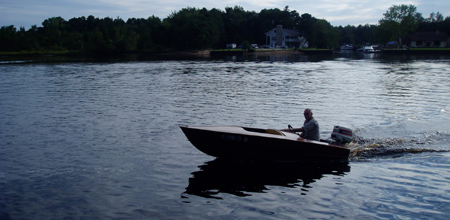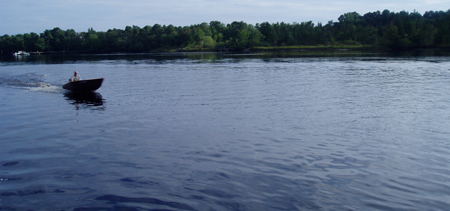
Paul Gager Builds an Original 1956 Ace
Paul Gager of New Jersey had already built an 8-foot dinghy and a 16-foot sailboat. He looked at a few old copies of the Boat Builder's Handbook and then found Svenson's web site where William D. Jackson's Ace plans from a 1956 Handbook are available. This was what he was looking for; plywood on frame construction, not too big, not many frames, not overly complicated, and it was similar to the type of boat his family had owned in his youth.
Paul drew the plans full size in his basement and started construction. Due to the change in lumber sizes over the years (a 2x is no longer 1-5/8" thick; nor is a 4x 3-5/8"), adjustments were necessary in stringer sizes.
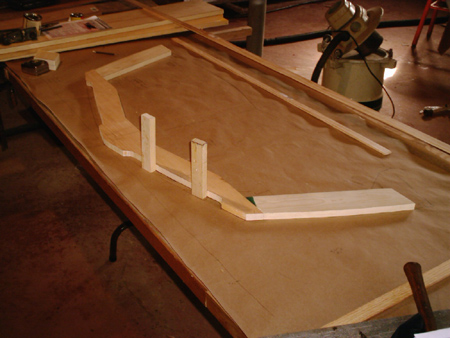
Paul cut some trial framing from pine boards to see how everything would fit together.
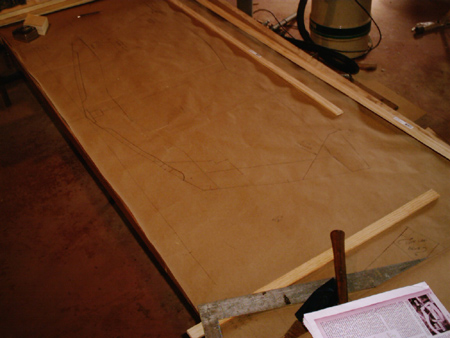
He laid out the frames full size using a roll of brown building paper and a lofting table made from two sheets of plywood.
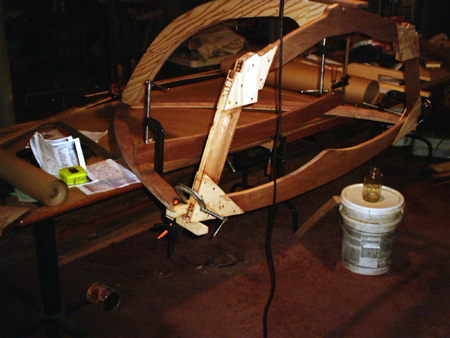
Here's the trial fit of the forward frame, rim pieces and stem. Everything fit after a little adjustment.
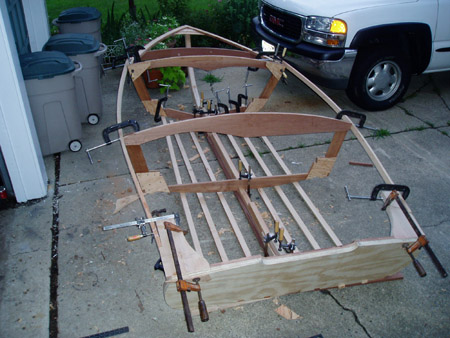 After all the frames were glued up and a major pieces were cut out, Paul clamped everything together to see how it fit. He found that the transom knees did not align properly and had to be adjusted. You can see were he modified the bottom framing, adding two more bilge battens on each side. The #2 frame was also modified from the original plans but the bottom contours were kept as original.
After all the frames were glued up and a major pieces were cut out, Paul clamped everything together to see how it fit. He found that the transom knees did not align properly and had to be adjusted. You can see were he modified the bottom framing, adding two more bilge battens on each side. The #2 frame was also modified from the original plans but the bottom contours were kept as original.
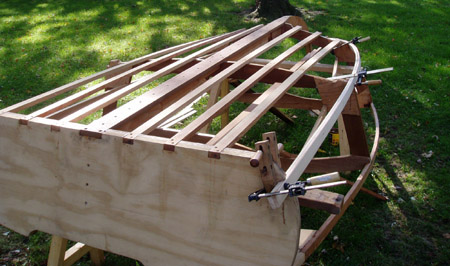
The framing was fastened together.
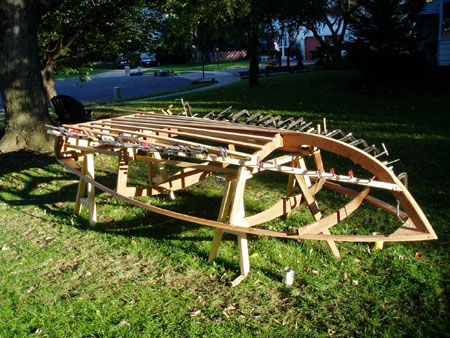 When the chines were installed the first time, they broke at the #1 frame when left overnight. Paul laminated them from two pieces of stock needing almost 50 clamps! It's tougher to get good lumber now than it was in the 50s and 60s.
When the chines were installed the first time, they broke at the #1 frame when left overnight. Paul laminated them from two pieces of stock needing almost 50 clamps! It's tougher to get good lumber now than it was in the 50s and 60s.
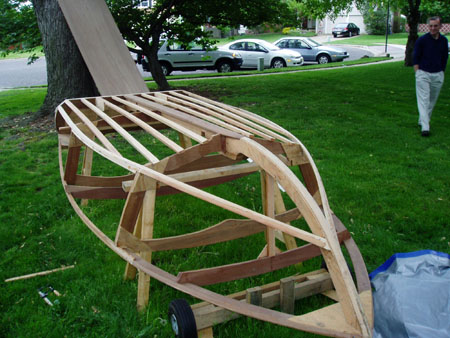
Paul's neighbor takes a look at the completed frame.
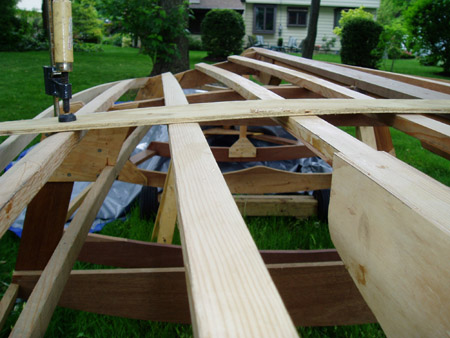
Paul checked the fairing of the bilge battens with a strip of 1/4" plywood as a batten.
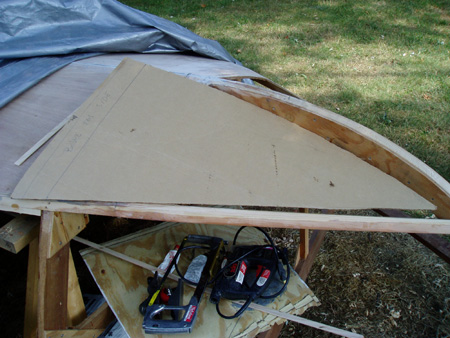
A cardboard pattern was used to fit the forward bottom plywood.
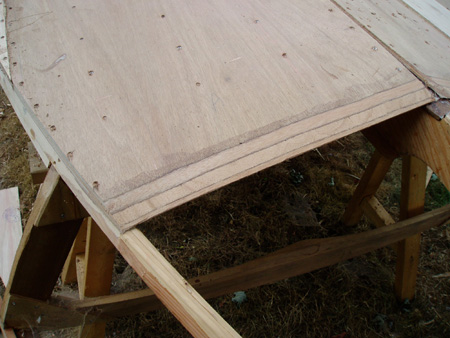
3/8" Philippine mahogany marine plywood was used on the bottom.
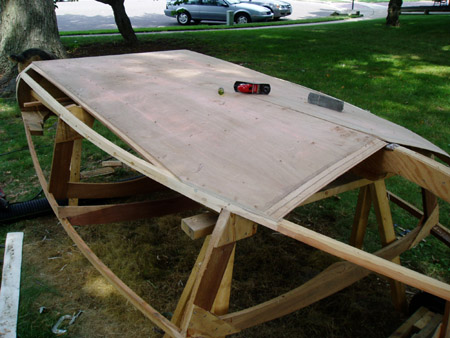
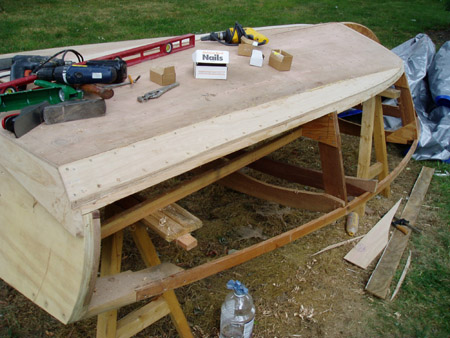
1/4" Mahogany plywood was used on the chines after packing the frames, transom and chines
with 1/8" strips of wood to make sure everything fit correctly.
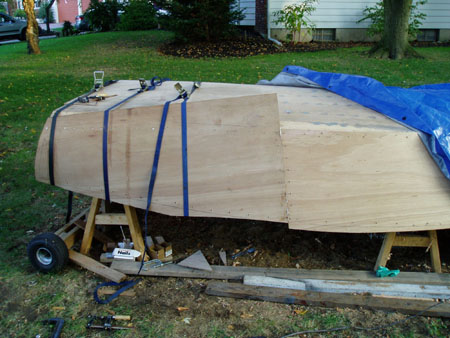
Three rachet straps were needed to pull the aft side planking into shape at the transom.
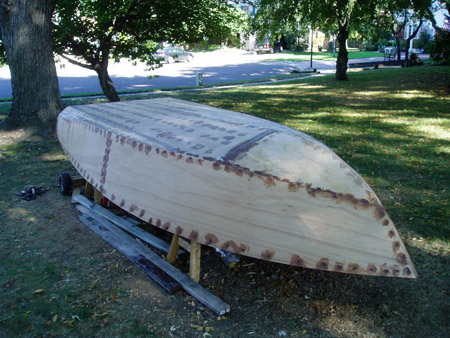
All of the screw heads were filled with epoxy fairing compound.
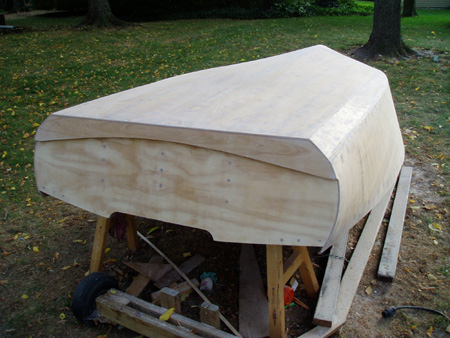
Here we see the transom tumblehome and "non-trip chines."
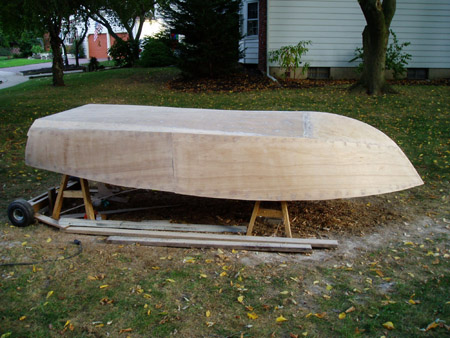
Although the plywood has not yet been trimmed along the gunwales,
sanding the epoxy essentially completed the planking!!
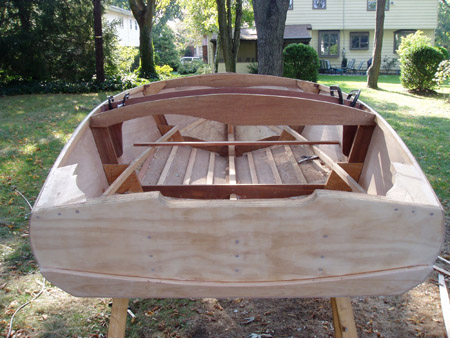
Right side up and looking good!
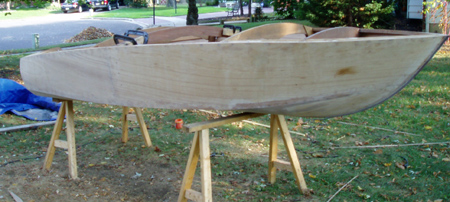
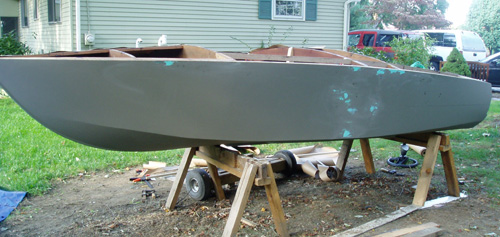
Here the hull has been coated with epoxy and primed. The blue spots are spot putty filling in some depressions, scratches etc. Paul will sand and apply at least one more coat of primer and possibly spot putty before he applies the final finish coats of paint.
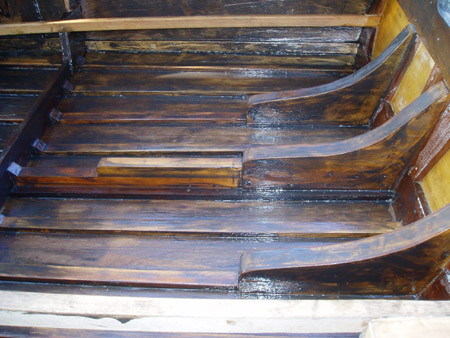
Here you can see Paul's modified framing. Jackson used framing of this type in some of his latter designs. Notice the 3 large transom knees. The Sande's used only the middle one. He applied a coat of "Cover It" epoxy over everything which accounts for the brownish color. It's not too smooth, so he'll sand it a little before he paints the inside.
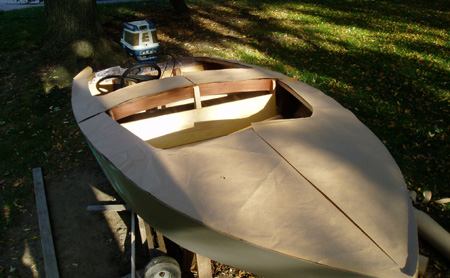
This shows Pauls's paper patterns for the decking. They allowed him to rough cut the plywood and make sure he could get everything from the two sheets of plywood he had available.
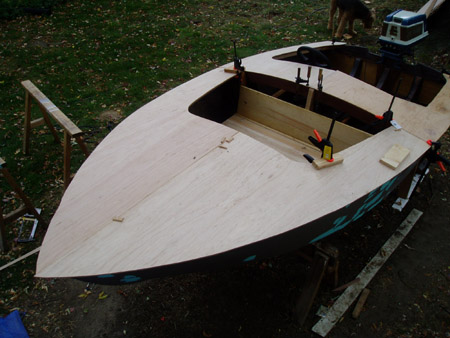
Here, Paul has clamped and tacked the rough cut plywood in position on the boat to make sure that everything will fit up correctly. Paul used "Meranti" marine plywood which will be stained "Red Mahogany" after filling the grain. Although it is not actual mahogany plywood, it will look very nice when finished.
Notice the late 1950s 18 HP Evinrude outboard. Paul has a newer 25 HP Johnson outboard which he will use during sea trials.
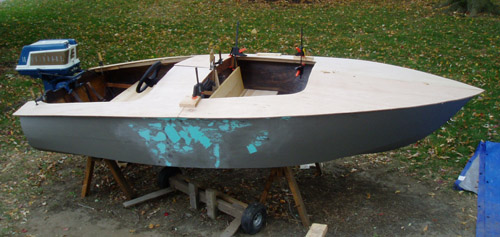
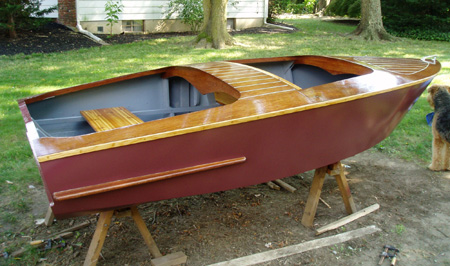
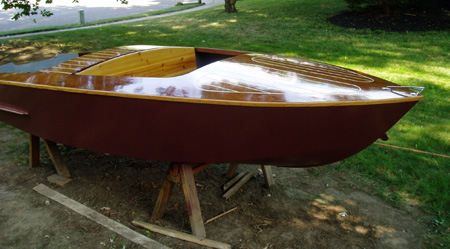
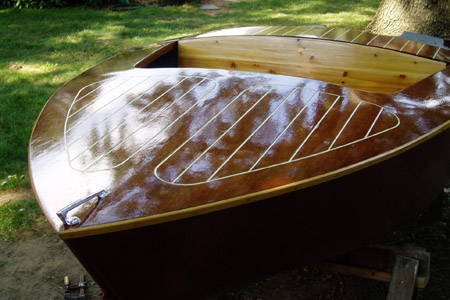
The stripes (faux plank decking) were formed by routing the pattern into the deck plywood before any finish was applied. After Paul stained and varnished the deck, he filled the grooves with vinyl caulking and applied a finish coat of varnish after the caulking had cured. Jackson originally showed the planking layout in the plans and gave more detailed instructions in the plans for the Playboy runabout. The idea to use vinyl caulking was from an article in an old copy of the Small Boat Journal. Jackson used a plaster mix but Paul is sure the caulking will hold up better than that.
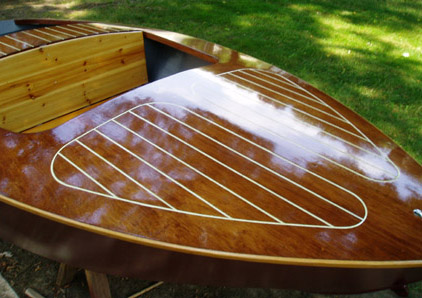
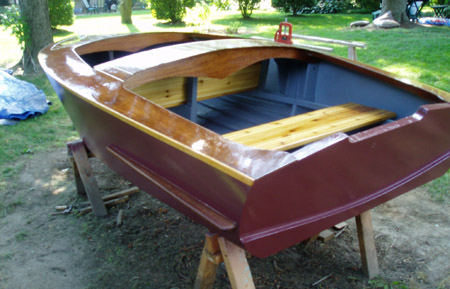
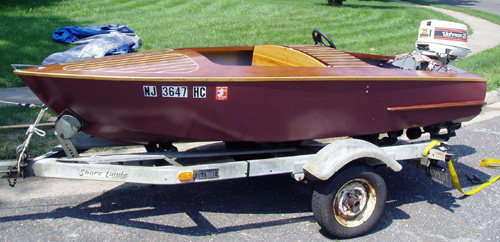 Here's the finished Ace sporting a 25 HP Johnson outboard!
Paul says that building outside isn't the way to go if you can avoid it. You lose days to inclement weather, hauling tools back and forth not to mention cleaning up each day. But thanks Paul! Your result -- a beautiful, well-constructed Ace -- justifies the effort!
Here's the finished Ace sporting a 25 HP Johnson outboard!
Paul says that building outside isn't the way to go if you can avoid it. You lose days to inclement weather, hauling tools back and forth not to mention cleaning up each day. But thanks Paul! Your result -- a beautiful, well-constructed Ace -- justifies the effort!
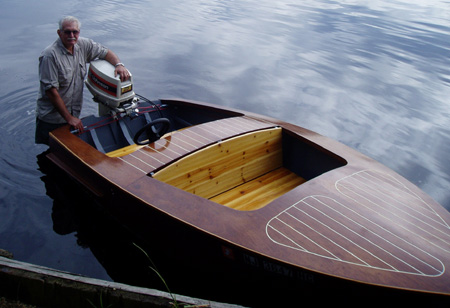
Paul with his Ace on the Mullica River in Green Bank, New Jersey.
